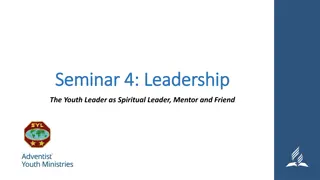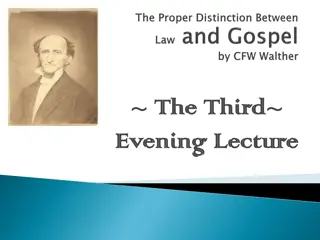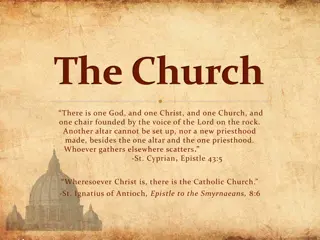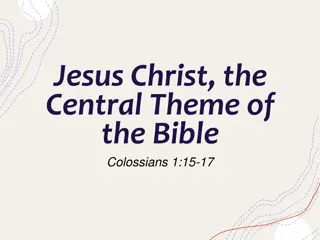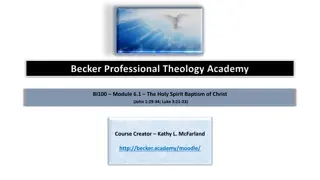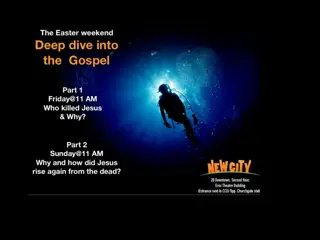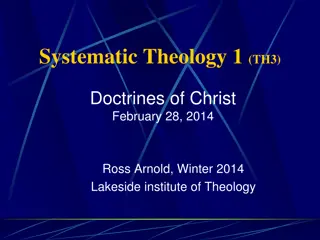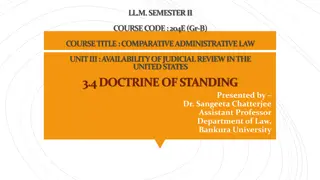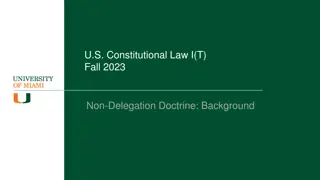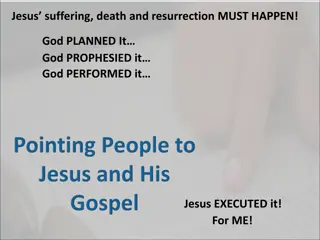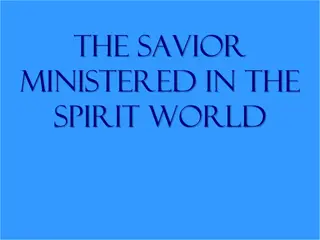Understanding the Two Natures of Jesus Christ in Christian Doctrine
The concept of the two natures of Jesus Christ, divine and human, is explored through various biblical references and historical heresies such as Docetism. The struggles over the doctrine of the Trinity and the nature of Christ are interconnected, emphasizing the importance of understanding Christ's dual nature. The denial of Christ's humanity, such as in the heresy of Docetism, challenges fundamental Christian beliefs. Through scriptural passages and historical context, the essential teachings on Christ's divinity and humanity are highlighted.
Download Presentation

Please find below an Image/Link to download the presentation.
The content on the website is provided AS IS for your information and personal use only. It may not be sold, licensed, or shared on other websites without obtaining consent from the author. Download presentation by click this link. If you encounter any issues during the download, it is possible that the publisher has removed the file from their server.
E N D
Presentation Transcript
Catechism Essentials of Faith Lesson 7 The Two Natures of the Christ
Hymn 23:1,2 Let us of Christ our Lord and Saviour sing, for, though God s equal, though eternal King, he did not to his rightful glory cling. Hallelujah, hallelujah! Himself he emptied that he us might save; himself for us, God s chosen ones, he gave, and, born as man, our Lord became a slave. Hallelujah, hallelujah!
Related Issues The struggles over the doctrine of the Trinity were closely related to the struggles over the doctrine of the natures of Jesus Christ. If Christ is not divine, there is no Trinity If there is no Trinity Christ is not divine. X X X
The Two Natures We distinguish two natures in the one Person of Jesus the Christ: divine and human We ll read together Athanasian Creed articles 29-37 and BC articles 18-19. Then we ll discuss the questions on the worksheet.
The Humanity Denied The denial of Christ s humanity dates back to the time of the New Testament. The Gospel written by John and the letter 1 John deal with this denial. Thus these two Bible books: - presume the divine nature of the Christ - argue in favour of the union of this divinity with the human nature
Illustration The divine nature presumed (John 1:1-3) In the beginning was the Word, and the Word was with God, and the Word was God. He was in the beginning with God. All things were made through him, and without him was not any thing made that was made. The human nature taught (John 1:14) And the Word became flesh and dwelt among us, and we have seen his glory, glory as of the only Son[d] from the Father, full of grace and truth.
The Humanity Denied: Docetism The denial of the humanity of Christ is generally known as the heresy of docetism. Docetismis from a Greek word meaning to seem like, appear like. Docetism will argue that the Son of God passed through the virgin Mary without taking on human properties from her. It s much like water passing through a garden hose without becoming rubber.
The Humanity Denied: Docetism Docetism probably has its origins in Greek thought that true life is spiritual, not material. This idea also leads to a rejection of the resurrection of the body. See Acts 17:32 and 1 Corinthians 15. Docetism was taught by early Anabaptist leaders, like Menno Simons. Mennonites originally come from the Low Lands. Hence the Belgic Confession specifically mentions this. Today s Mennonites, however, hold a conviction similar to our own. (cf. Mennonite Confession art. 2)
The Divinity Denied The denial of the divinity of Christ dates back to the 2nd century AD. It gained prominence in the 4th century AD through Arius. Arius wrote in a letter: But we say and believe and have taught, and do teach, that the Son is not unbegotten, nor in any way part of the unbegotten; and that he does not derive his subsistence from any matter; but that by his own will and counsel he has subsisted before time and before ages as perfect God, only begotten and unchangeable, and that before he was begotten, or created, or purposed, or established, he was not. For he was not unbegotten. We are persecuted, because we say that the Son has a beginning, but that God is without beginning.
The Divinity Denied Arius appealed especially to the word only-begotten in the writings of John. (!) Arius argument was: something that is begotten has a beginning. The counter-argument is: a. We know Christ is without beginning John 8:58: Before Abraham was, I AM. b. Begotten does not refer to a begin- ning of existence, but to an identity of essence. Jesus the Christ is the only one who shares the essence (nature) of the Father.
The Two Natures Together The teachings of Arius focused the attention of many people on the question how the two natures related to each other, leading to many heresies. Nestorius taught: there are 2 natures and 2 persons. Eutyches taught: the human nature is absorbed into the divine nature, hence 1 nature, 1 person. Apollinarius taught: the divine nature replaced the thinking principle ( mind ) of the human nature. There are more variations, such as monothelitism (two natures, one will) and miaphytism (the two natures are united into one).
The Two Natures Together Many heresies were responded to by the Council of Chalcedon, 451. It concluded concerning the natures: the natures are not confused, not changed, not divided and not separated. Note that Chalcedon did not make a positive statement, but a negative statement. Human attempts to make the co-existence of the two natures in one person rationally acceptable lead to heresies. However, the two natures in the one person is a mystery, like the Trinity.
The 21st Century The following positions are still present today. Arianism is taught by Muslims and Jehovah s Witnesses. Arianism is also taught by many liberal theologians in mainstream churches (e.g., United Church of Canada) Myaphysitism is held by some Eastern Orthodox and some Catholic churches; it is also held by some Anglican theologians. Thus, a very relevant issue!




